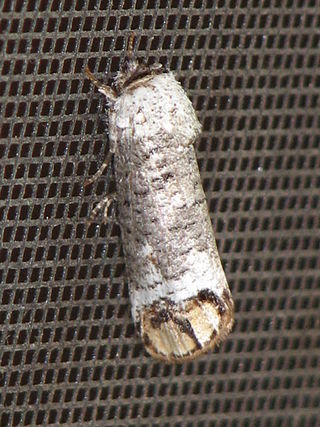
The American bushtit, or simply bushtit, is a social songbird belonging to the genus Psaltriparus. It is one of the smallest passerines in North America and it is the only species in the family Aegithalidae that is found in United States; the other seven species are found in Eurasia.

The Noctuidae, commonly known as owlet moths, cutworms or armyworms, are a family of moths. Taxonomically, they are considered the most controversial family in the superfamily Noctuoidea because many of the clades are constantly changing, along with the other families of the Noctuoidea. It was considered the largest family in Lepidoptera for a long time, but after regrouping Lymantriinae, Catocalinae and Calpinae within the family Erebidae, the latter holds this title now. Currently, Noctuidae is the second largest family in Noctuoidea, with about 1,089 genera and 11,772 species. This classification is still contingent, as more changes continue to appear between Noctuidae and Erebidae.

Attacus atlas, the Atlas moth, is a large saturniid moth endemic to the forests of Asia. The species was described by Carl Linnaeus in his 1758 10th edition of Systema Naturae.

Rothschild's birdwing is a large birdwing butterfly, endemic to the Arfak Mountains in Western New Guinea.

The Cossidae, the cossid millers or carpenter millers, make up a family of mostly large miller moths. This family contains over 110 genera with almost 700 known species, and many more species await description. Carpenter millers are Lepidoptera found worldwide, They are nocturnal, except for the Southeast Asian subfamily Ratardinae.

The silver-tipped myotis is a species of mouse-eared bat found in a range of lowland habitats in the Americas.

The little sparrowhawk is a species of Afrotropical bird of prey in the family Accipitridae. It was formerly placed in the genus Accipiter. It is the smallest member of the genus Tachyspiza and forms a superspecies with the red-thighed sparrowhawk.

Phragmataecia castaneae, the reed leopard or giant borer, is a moth of the family Cossidae. It was described by Jacob Hübner in 1790. It is found in central and southern Europe, the Middle East, the Caucasus, Transcaucasia, Turkmenistan, Kazakhstan, north-western Iran, Iraq, Syria, Sri Lanka, Madagascar, India, Lebanon, Turkey, western China, south-western Siberia, Egypt, Tunisia and Morocco.

Hyles livornica, the striped hawk-moth, is a moth of the family Sphingidae.

Pachycereus pecten-aboriginum is a columnar cactus plant native to Mexico. They can grow up to 15 m (49 ft) high. The trunk of this species is 1.2 to 5.0 m tall and the fruits are large and burr-like. The specific name, pecten-aboriginum, is from the Latin, and means "native combs". It was inspired by the use of the fruits as hair combs.

Patoptoformis is a genus of moths belonging to the family Cossidae.

Phragmataecia monika is a species of moth of the family Cossidae. It is known only from the Qinliangfeng mountain in Zhejiang province of eastern China.
Phragmataecia geisha is a species of moth of the family Cossidae. It is found in Japan.
Phragmataecia gurkoi is a species of moth of the family Cossidae. It is found in north-western Pakistan.

Xyleutes is a genus of moths belonging to the family Cossidae and typical of the tribe Xyleutini.

The Zeuzerinae are a subfamily of the family Cossidae.
Assegaj is a monotypic genus of moths in the family Cossidae. Its sole species is Assegaj clenchi, which is found in Cameroon, the Republic of Congo and Nigeria.

Duomitus is a monotypic moth genus in the family Cossidae described by Arthur Gardiner Butler in 1880. Its only species, Duomitus ceramicus, described by Francis Walker in 1865, is found in Yunnan in China and from southern India and Malaysia to Sumatra, Ceram and New Guinea.
Barchaniella inspersus is a moth in the family Cossidae. It was described by Hugo Theodor Christoph in 1887. It is found in Kyrgyzstan, Afghanistan, Kazakhstan, Uzbekistan, Turkmenistan, north-western China and south-western Mongolia.

Stenaelurillus pecten is a species of jumping spider in the genus Stenaelurillus that lives in Botswana and Zambia. It was first described in 2014 by Wanda Wesołowska. The spider is small, with a brown cephalothorax between 2.3 and 3.1 mm in length and a black abdomen between 2.2 and 3.6 mm long. The carapace has a line of brushes around it, formed of white hair. It is distinguished from other members of the genus by the comb-like appendage on the male's palpal bulb, after which the spider gets its name. The female has a distinctive arrangement of the copulatory openings in the epigyne.
















